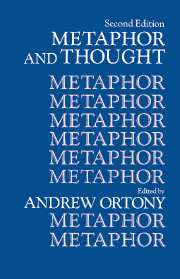Book contents
- Frontmatter
- Contents
- List of contributors
- Preface to the second edition
- Preface to the first edition
- 1 Metaphor, language, and thought
- METAPHOR AND MEANING
- METAPHOR AND REPRESENTATION
- METAPHOR AND UNDERSTANDING
- 14 Psychological processes in metaphor comprehension and memory
- 15 The interpretation of novel metaphors
- 16 The role of similarity in similes and metaphors
- 17 Images and models, similes and metaphors
- 18 How metaphors work
- 19 Metaphor and irony: Two levels of understanding
- METAPHOR AND SCIENCE
- METAPHOR AND EDUCATION
- References
- Author index
- Subject index
17 - Images and models, similes and metaphors
Published online by Cambridge University Press: 05 June 2012
- Frontmatter
- Contents
- List of contributors
- Preface to the second edition
- Preface to the first edition
- 1 Metaphor, language, and thought
- METAPHOR AND MEANING
- METAPHOR AND REPRESENTATION
- METAPHOR AND UNDERSTANDING
- 14 Psychological processes in metaphor comprehension and memory
- 15 The interpretation of novel metaphors
- 16 The role of similarity in similes and metaphors
- 17 Images and models, similes and metaphors
- 18 How metaphors work
- 19 Metaphor and irony: Two levels of understanding
- METAPHOR AND SCIENCE
- METAPHOR AND EDUCATION
- References
- Author index
- Subject index
Summary
I shall try to defend a version of the traditional view that a metaphor is an abbreviated simile, and that the thought provoked is the kind required to appreciate similarities and analogies. In the nineteenth century that kind of thought was called “apperception.”
“Apperception” is one mentalistic term that has not been rehabilitated by cognitive psychologists in recent years; perhaps it is time we got around to it. For Herbart (1898) “apperception” was a general term for those mental processes whereby an attended experience is brought into relation with an already acquired and familiar conceptual system. Today our psychological journals are full of terms like “encoding,” “mapping,” “categorizing,” “inference,” “assimilation and accommodation,” “attribution,” and so on; perhaps “apperception” would be a useful superordinate for all of them.
If I understand Herbart correctly, his general claim was that new things are learned by being related to things already known; he built his educational psychology on the belief that if teachers know what their pupils know, they can relate ideas they want to teach to ideas the pupil has already mastered. Although Herbart's term has passed from fashion, the educational philosophy of maximizing transfer of training seems as sensible now as it did a century ago. In my view, much of the scientific interest of an analysis of metaphor derives from what it might contribute to a theory of apperception appropriate to the psychological and educational concepts of the twentieth century.
- Type
- Chapter
- Information
- Metaphor and Thought , pp. 357 - 400Publisher: Cambridge University PressPrint publication year: 1993
- 48
- Cited by



